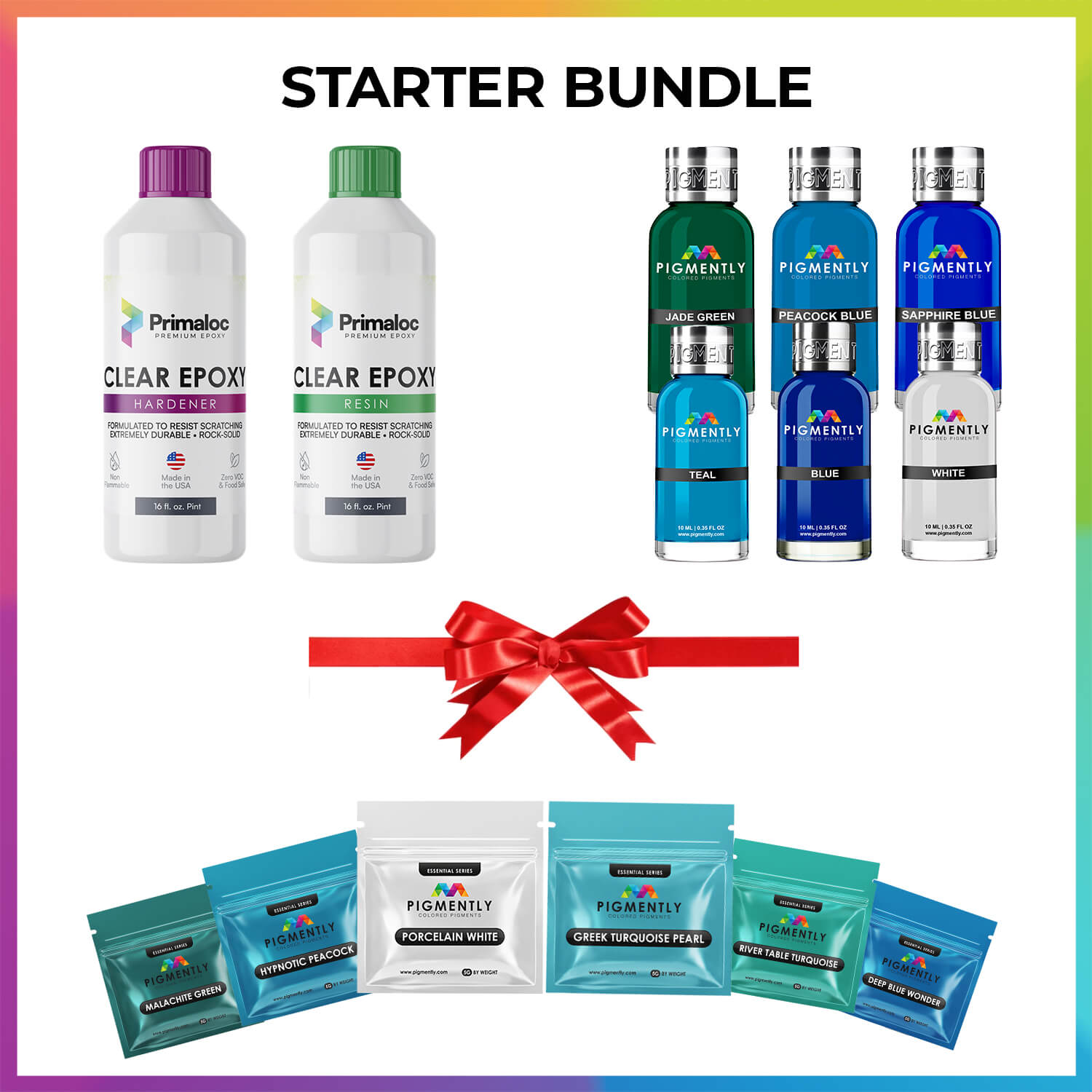Welcome to Pigmently, our online store for high-quality mica powder pigments and liquid dyes.
Epoxy resin, despite being known as a clear, glossy substance, is actually incredibly receptive to certain types of pigments. With the right selection, you can infuse your epoxy resin with anything from brilliant neon tones, to soft, subtle pastels, to shiny metallic textures, to even something that glows in the dark.
But while there are several types of colorants that work for epoxy to some extent, there is only one type that truly meshes with its unique makeup to provide a truly stunning—and long-lasting—result.
In this article we'll explain what pigment is best for epoxy resin, then we'll explain how to apply it. After that, we'll also mention a couple of additional colorant options for those who'd like to consider potential alternatives.
What Pigment Is Used for Epoxy?
By far, the best pigment choice for epoxy resin is mica powder. This type of pigment is a dry, powdery mineral-based colorant created primarily from mica minerals.
Mica powder pigments are colorfast, insoluble, and reflective. This makes them outstanding well suited for use in epoxy resin, which presents as a liquid before undergoing a hardening chemical reaction known as curing.
What Is Mica?
Mica is the name of a group of 37 different silicate minerals. These minerals have a couple of distinct, shared traits:
- Mica minerals are reflective, meaning that light is not absorbed by them.
- Mica minerals also exhibit perfect mineral cleavage, which means they can be cut in smooth sheets, making it easy to mine, clean, and process into tiny particles to form mica powders.
While all of these minerals have functional and aesthetic uses—and can be quite beautiful, there are actually only two of them that tend to be widely used. These two are phlogopite and muscovite.
Mica minerals exist in a sizable range of colors. When these minerals are mined, clean, and ground into a powder, they are often augmented with additional colorful additives to further widen the range of hues available.
In other words, a mica powder pigment doesn't have to be solely made from mica; it just needs to be primarily mica, a notable distinction that allows for much more color/texture variety.
At Pigmently, we offer our own selection of high-grade mica powder pigments.
How Do You Mix Pigment with Epoxy?
Properly mixing mica pigments into your epoxy is actually quite a simple process. The biggest trick is determining how much mica powder you need to achieve the look you want.
Because a premium mica powder will be highly concentrated, it only takes a little to see remarkable results. We often recommend that users start with a small amount, and then increase it from there until they've reach a point of satisfaction.
For mica to epoxy ratios, the recommended starting points vary. Because each mica pigment brand will differ from others in quality and potency, there isn't a "one size fits all" solution.
That being said, for our Pigmently mica powder pigments, many users elect to start with 16 grams of powder pigment per gallon of epoxy.
Click here to learn more about mica powder to epoxy ratios.
Here's a short step-by-step guide to mixing pigment with epoxy:
- Measure out your epoxy resin batch. Be sure to adhere to the ratio of your chosen epoxy brand (usually 1:1).
- Begin mixing it. At some point during this, you can pause to add pigment to your batch. Start small and add more as needed to achieve your desired tones.
- Finish mixing the batch. The instructions for your epoxy brand should indicate how long this will take.
- Apply your now-tinted epoxy resin batch.
That's it. It's relatively simple to use pigment with epoxy. The key acquiring getting high-quality pigment and resin, which will be more receptive to each other and less likely to present issues such as clumping or blemishes upon curing.
Some people prefer to mix their pigment into the hardener half of the epoxy batch. This is done by measuring out the hardener component, but not the resin component. From there, one can add the pigment, mixing it in to achieve a satisfying tone, then add the resin component afterward to fully blend the epoxy and start the curing process.
The downside to that method is that you won't have the full volume of the epoxy batch to gauge the color of it. By adding the resin component, it will dilute the intensity of the color and you may need to add more pigment.
Which Pigments Are Best for Resin?
Our Pigmently Mica Powder Pigments are the best option for giving your resin a beautiful, shimmering color.
Pigmently pigments are potent, colorfast, and non-fading, an ideal combination for epoxy resin. This combination provides a long-lasting finish that won't fade or crack, and handles outdoor environments well, too!
Pigmently: Your Trusted Source for Premium Mica Powder for Epoxy
At Pigmently, we're committed to providing premium colorants for DIY creators of any skill level. All of our mica powder pigments are produced to a carefully refined formula.
By using only high-grade ingredients to ensure clean and potent results, we're able to maintain our high standards for quality assurance. This allows us to offer our users a selection of exceptional pigments that blend incredibly well with epoxy resin.
In our store, you'll find a wide array of premium mica powders to use in your creations. You can also view our premium liquid dyes collection, which are also suited for epoxy resin projects. Finally, we also carry the excellent Primaloc Art and Craft Epoxy.
If you find yourself interested in multiple shades, consider our curated Colorant Value Bundles, which are cost-effective ways to obtain a variety of colorful mica powder pigments.
Bring your creations to life with premium Mica Powder Pigments by Pigmently!



